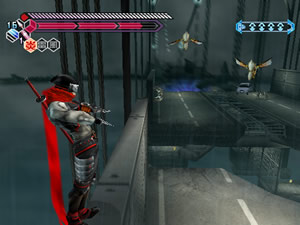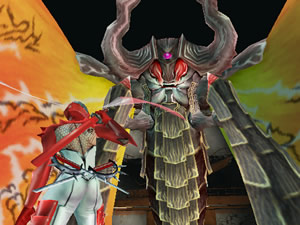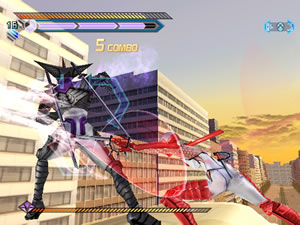She-nobi?
Some have said of life that its essence is aqueous and so subtle in its subservience to form and rules as to be like water in a jar. Used to the shape imposed on our lives by habit and convention, we almost forget what change means until some shocking revelation shatters yesterday’s shot-glass and replaces it with the stein of new frontiers.
Okay, so that might be overstating it, but in many ways I like Nightshade for
the PS2 that much. The game recaptures the intensity and tight control of its
2D forbears, serving up a blisteringly fast-paced action extravaganza.
Which isn’t to say that it’s very unique. In fact, this pseudo-sequel to 2002’s
Shinobi looks and plays much like its male equivalent’only
better.
But then there’s the plot, which fails. In Nightshade, you play
as Hibana, a female ninja working for the Japanese government. Evidently, a gang
of baddies (reminiscent of the Devils of Kimon from Ninja Scroll) you used to
roll with has shattered the cursed blade Akujiki and is using it to unleash scores
of monsters on the hapless Japanese population. Hibana’s mission is to kill everyone
involved, a process that finally culminates in her kicking her former master’s
(and lover’s) ass.
The big problem is Hibana’s frigid demeanor. As femininely provocative as she appears in her skin-tight, leather ninja-suit, she’s as hard and cold as a dominatrix. In the most interesting and most disturbing episode, she answers a question posed by a mortally wounded boss with a quick slash of her sword, eviscerating him. The subtext of the conversation has been his unrequited love for Hibana, but out of spite and jealousy he is only able to chide her for being used sexually by Jumichi (their master). Hibana, clearly unable to feel any emotion other than mild irritation and shame, answers the only way she knows how: with her sword. So ends (well, actually it drags on a little longer) the most tragic, pathetic, fascinating yet disappointing dialogue I’ve ever seen in a video game. Unfortunately, every other cut-scene is used to relate some trite one-liner or further the boring plot.
The rest of Nightshade can be divided into two parts: levels and boss battles. Levels can be further divided into two categories: normal and moving. The same goes for boss battles, which pits Hibana versus super-humans or super-monstrosities.
The typical levels usually involve a series of chambers or arenas that Hibana may only exit when she smashes the requisite number of mirrors or enemies. As lame and predictable as this may sound, the fighting is good enough to make up for the ubiquity.
The basics of Hibana’s butt-kicking include the usual suspects: running, jumping,
kicking, slicing, dashing and targeting, each of which has multiple uses. For
example, kicking can be done while standing or jumping and can effectively deflect
air-born projectiles, stun enemies, knock the armor off enemies, and extend Hibana’s
jumping abilities. Hibana can also kick enemies into the air, leap after them
and then smash them to the ground, resulting in a shockwave that stuns all nearby
foes.
Hibana wields three swords: one long and two short. The long sword is much more damaging than the short swords and is good for quick kills, while the short swords are less damaging, look cooler and strike rapidly. The differences in speed and damage directly affect two other play mechanics in Nightshade: the stealth-attack meter and Tate-combos.
The stealth-attack meter builds minutely each time Hibana strikes an enemy, so
if she uses the short swords and hits an enemy 10 times before killing it,
she’ll build up her stealth-attack meter more than she would have if she simply
had single-sliced the foe with her long sword. Once the meter is built up sufficiently,
Hibana may unleash her stealth-attack, a massively damaging projectile attack
that’s really only useful for quickly diminishing a boss’ health.
 Tate-combos, conversely, are based on a meter that’s filled each time Hibana kills an enemy, and quickly runs out’unless Hibana kills another enemy, and another and another, and so on. With each successive kill Hibana’s attack power increases, to the extent that she could eventually kill any enemy in the game in just one hit – provided she had built up enough of a Tate-combo (the best I’ve done so far was a 30-tate).
Tate-combos, conversely, are based on a meter that’s filled each time Hibana kills an enemy, and quickly runs out’unless Hibana kills another enemy, and another and another, and so on. With each successive kill Hibana’s attack power increases, to the extent that she could eventually kill any enemy in the game in just one hit – provided she had built up enough of a Tate-combo (the best I’ve done so far was a 30-tate).
In each level, Hibana is faced with groups of enemies. A meter at the top right of the screen conveniently keeps track of how many enemies are in a group and how many Hibana has killed; if Hibana is able to kill them all in a single Tate-combo, she is rewarded with a dramatic cut-scene (obviously meant to make Nightshade more cinematic, though they look silly and affected). While the groups of enemies range from effortless to pretty tough, it is the momentum Hibana builds as her Tate-combo grows that makes these otherwise static battles so exciting and refreshing.
The point of all these meters and combos and whatnot is to make Hibana that bad-ass ninja in the movies who shows up on a scene and suddenly kills everyone’except in Nightshade, you get to see it and do it. It’s just tons of fun.
And nothing in Nightshade is as difficult or as rewarding as
any of the several boss battles. Generally, there are two paths you can take
in any given boss battle: try and kill all the cronies and inflict a Tate-induced
death-blow; or learn how to exploit one of their behavioral patterns and do enough
damage to kill the boss before it kills you. Both methods require intense patience
and insane acts of dexterity. One of my favorite experiences was jumping into
a giant boss’ face and, through some fancy jumping, kicking and slashing, staying
there until I’d killed it.
Unfortunately, there is a dark side to every ninja. In this case, it starts with terrible level design, featuring drab backgrounds, no civilians, and just nothing really to make things interesting. There are also too few enemy types, so get used to kicking the same asses over and over again. But in many ways, the action is so good and you kick SO MUCH ASS that you won’t even really notice these shortcomings until you sit down to write a review and are forced to think about such things.
On the other hand, even the deaf, dumb and blind will notice a recurrence of the cheap death situation the plagued Shinobi. Certain levels force you to keep moving, leading to frustration because you can easily fall and die. For example, in one level Hibana must jump from truck to truck on a freeway while killing enemies. Sometimes you’ll attack an airborne enemy, kill it, and then realize that he’s out over the street with nowhere to go. Such circumstances are easily avoided by making sure you leave an enemy alive on the truck to lock-onto and dash back to, but it’s still annoying.
 The moving levels are also stricken with some programming flaws. At certain points
The moving levels are also stricken with some programming flaws. At certain points
Hibana must leap onto the side of a moving big rig, run all the way down it
and either leap onto another truck or across the freeway to another big rig.
However, sometimes Hibana will become miraculously detached from the sides
of the trucks and die instantly. At other times she will leap away to find
that for some reason she can’t dash or make another jump. I’m not sure what
causes this to happen but it can be very frustrating when it does, especially
since Hibana always starts the truck level from the beginning if she dies.
Graphically, Nightshade is a mixed bag. Dull environments and
bland enemies are offset by excellent animations and a steady 60 frames per second.
If you were to pause Nightshade or scrutinize a screen shot,
you probably wouldn’t be impressed, but when things get moving it winds up looking
pretty good.
The sound meets the same fate. Nightshade‘s music is fast-paced electronica that fits the action and the sound effects are clear, but there are no ambient noises and enemies never say anything (except for bosses).
In terms of raw action and cathartic gratification, Nightshade is a great experience, even as it fails in several other important areas. If you have wimpy thumbs and are averse to difficulty, you probably ought to let this ninja go. But if you consider yourself the hardest of the hardcore, I recommend letting Nightshade kick your ass a little. Or a lot.
-
Insane, intense action
-
Terrific boss battles
-
Smooth, fast and hard
-
Which might be too much for some
-
Cheap deaths
-
Bad level design and too few enemy types











